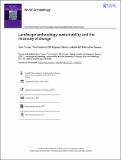Files in this item
Landscape archaeology, sustainability and the necessity of change
Item metadata
| dc.contributor.author | Turner, Sam | |
| dc.contributor.author | Kinnaird, Tim | |
| dc.contributor.author | Koparal, Elif | |
| dc.contributor.author | Lekakis, Stelios | |
| dc.contributor.author | Sevara, Christopher | |
| dc.date.accessioned | 2021-07-13T08:30:05Z | |
| dc.date.available | 2021-07-13T08:30:05Z | |
| dc.date.issued | 2021-06-18 | |
| dc.identifier | 274893348 | |
| dc.identifier | c6b45d02-0b1b-4e68-9a35-8790b525551e | |
| dc.identifier | 000663201300001 | |
| dc.identifier | 85108206848 | |
| dc.identifier.citation | Turner , S , Kinnaird , T , Koparal , E , Lekakis , S & Sevara , C 2021 , ' Landscape archaeology, sustainability and the necessity of change ' , World Archaeology , vol. 52 , no. 4 , pp. 589-606 . https://doi.org/10.1080/00438243.2021.1932565 | en |
| dc.identifier.issn | 0043-8243 | |
| dc.identifier.other | RIS: urn:3E4FCA0CB033D867BDD87334A5D2E8C9 | |
| dc.identifier.uri | https://hdl.handle.net/10023/23528 | |
| dc.description | Funding: Survey and dating of terraces on the Çeşme peninsula was supported by the British Academy through a Newton Advanced Fellowship awarded to EK, and community workshops by the Municipality of Izmir. Participatory workshops on Naxos were funded by the UK Arts and Humanities Research Council (AH/P014453/1), Newcastle University and the European Commission (H2020 657050), which also supported development of the Rescaper Tracker mobile app. Ongoing field research is part of the TerraSAgE project (funded by UKRI-AHRC, AH/T000104/1). An exploratory visit to Jiayuguan was supported by the Wall-to-Wall initiative and the Chinese Academy of Cultural Heritage. | en |
| dc.description.abstract | For future landscapes to be sustainable, significant changes in land-use and management practices will be needed. This article argues that landscape archaeology can make distinctive contributions to sustainability in two ways: firstly, by researching what were and were not sustainable ways of life in the past, and secondly by using this knowledge to explain how landscapes of the past differed to those in the present, and in doing so to disrupt the invented connections between past societies, tradition, heritage and conservation. The article draws on three case-studies in China, the Mediterranean and the UK to suggest that archaeological knowledge could be used to help stakeholders imagine future landscapes which are better and more sustainable than those of today. To succeed archaeologists will need to make deeper commitments to transdisciplinary work. | |
| dc.format.extent | 18 | |
| dc.format.extent | 16219964 | |
| dc.language.iso | eng | |
| dc.relation.ispartof | World Archaeology | en |
| dc.subject | Landscape | en |
| dc.subject | Sustainability | en |
| dc.subject | Agriculture | en |
| dc.subject | Transdisciplinary | en |
| dc.subject | GE Environmental Sciences | en |
| dc.subject | CC Archaeology | en |
| dc.subject | NDAS | en |
| dc.subject | SDG 15 - Life on Land | en |
| dc.subject | MCC | en |
| dc.subject.lcc | GE | en |
| dc.subject.lcc | CC | en |
| dc.title | Landscape archaeology, sustainability and the necessity of change | en |
| dc.type | Journal article | en |
| dc.contributor.institution | University of St Andrews. School of Earth & Environmental Sciences | en |
| dc.identifier.doi | 10.1080/00438243.2021.1932565 | |
| dc.description.status | Peer reviewed | en |
This item appears in the following Collection(s)
Items in the St Andrews Research Repository are protected by copyright, with all rights reserved, unless otherwise indicated.

